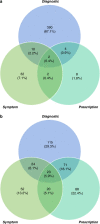Incidence of anxiety and depression in children and young people with life-limiting conditions
- PMID: 36369475
- PMCID: PMC10313520
- DOI: 10.1038/s41390-022-02370-8
Incidence of anxiety and depression in children and young people with life-limiting conditions
Abstract
Background: The aim of this study was to investigate the incidence of anxiety and depression in children and young people with life-limiting conditions.
Methods: A comparative cohort study was conducted, using primary and secondary care data from the Clinical Practice Research Datalink (CPRD) in England. Anxiety and depression codes were identified using diagnostic, symptom and prescription codes. Incidence rates of anxiety and depression were compared across condition groups using Poisson regression, adjusting for sex, age, ethnicity, and deprivation status.
Results: A total of 25,313 children and young people were included in the study: 5527 with life-limiting conditions, 6729 with chronic conditions, and 13,057 with no long-term conditions. The incidence of anxiety (IRRadj: 1.39, 95% CI: 1.09-1.77) and depression (IRRadj: 1.41, 95% CI: 1.08-1.83) was significantly higher in children and young people with life-limiting conditions, compared to children and young people with no long-term conditions.
Conclusions: The higher incidence of anxiety and depression observed among children and young people with life-limiting conditions highlights the need for psychological support in this population, including further efforts to prevent, identify, and treat anxiety and depression.
Impact: The analysis of primary and secondary healthcare data from England revealed that the incidence of anxiety and depression was higher among children and young people with life-limiting conditions, compared to those with no long-term conditions. This is the first study to investigate the incidence of anxiety and depression in children and young people with a wide range of life-limiting conditions. The higher incidence of anxiety and depression observed in children and young people with life-limiting conditions highlights the need for psychological support aiming to prevent, identify, and treat anxiety and depression in this population group.
© 2022. The Author(s).
Conflict of interest statement
The authors declare no competing interests.
Figures





